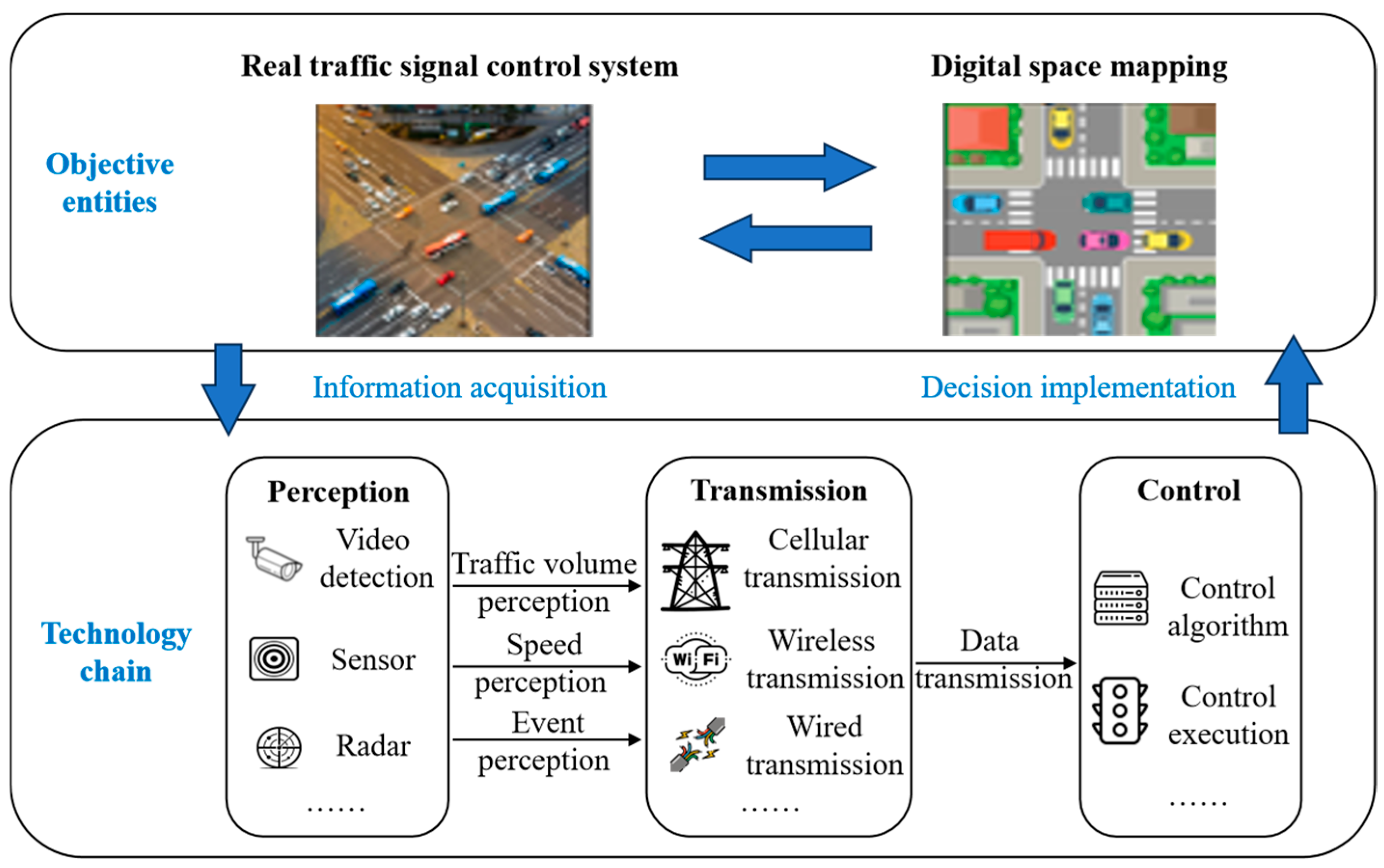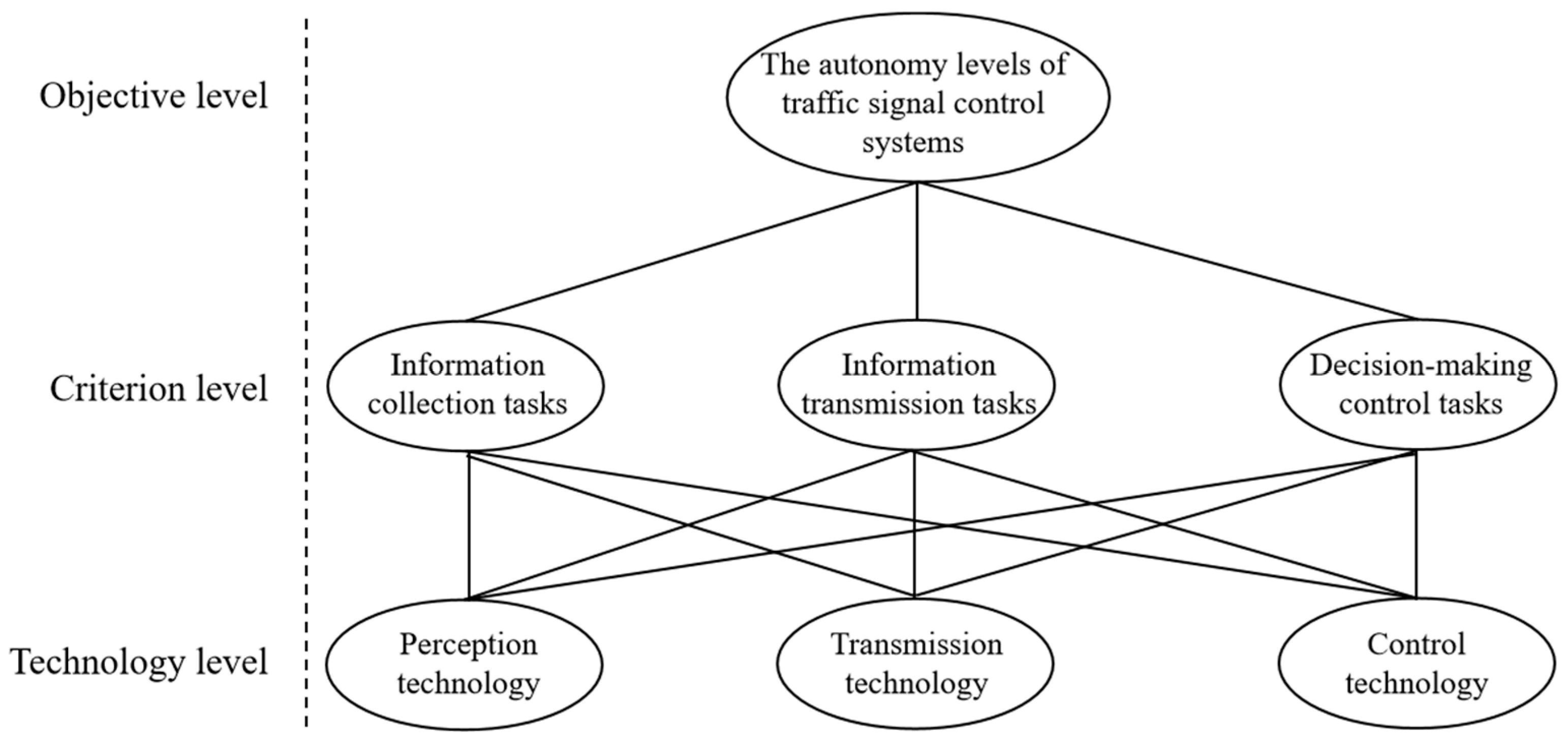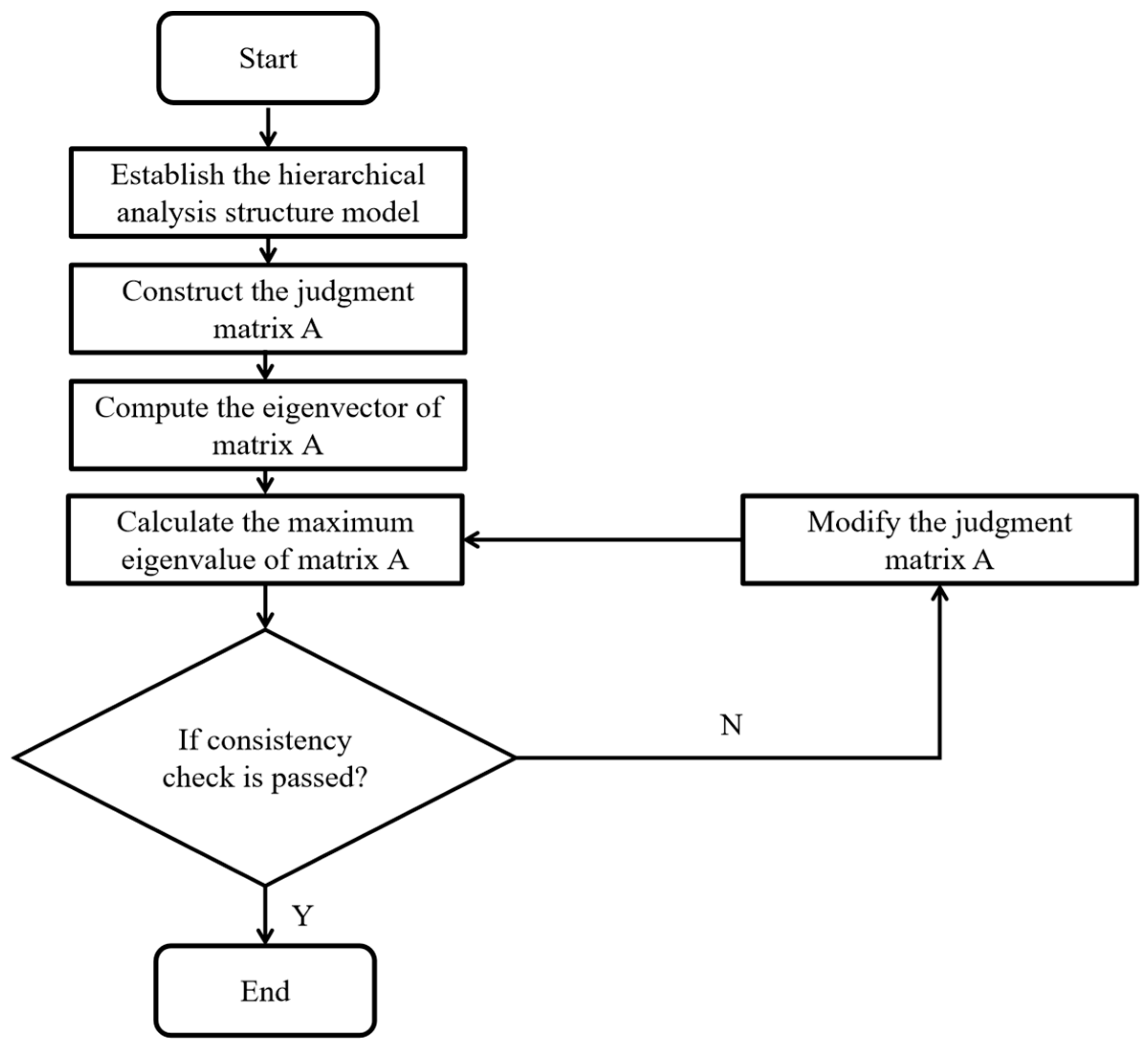4.1. Calculation of Indicator Weights Based on the AHP Method
4.1.1. Calculation of First-Level Indicators
Weight calculations were conducted for first-level indicators information collection (A), information transmission (B) and decision-making control (C). After ensuring that the 20 expert judgment matrices met the consistency requirement (CR < 0.1), these matrices are aggregated using Equation (2). The aggregated matrix is shown in
Table 4:
Weight and consistency calculations are conducted on the judgment integration matrix for first-level indicators, specifically including information collection (A), information transmission (B) and decision-making control (C), using Equations (3)–(6). The results of the weight calculations for these indicators are presented in
Table 5.
It shows that decision-making control (C) plays a critical role in enhancing autonomy levels and holds significant weight. In contrast, information collection (A) contributes less to autonomy. This demonstrates that while perception technology serves as a foundation, reliance solely on perception cannot achieve advanced system autonomy. Although information transmission (B) occupies an intermediate position, it acts as a crucial link that supports both decision-making control and perception technology. This ensures the system’s capability for real-time information exchange and effective scheduling.
Therefore, when enhancing the autonomy level of traffic signal control systems, particular emphasis should be placed on advancing control technologies. Additionally, it is important to strengthen information transmission capabilities and optimize sensing technologies. This approach ensures that all technologies work coordinately during the autonomy enhancement process. Ultimately, these efforts collectively drive the system toward highly intelligent and globally optimized development.
The judgment integration matrix and weight calculation results for the second-level and third-level indicators are obtained using the same calculation steps as those for the first-level indicators. The detailed results are presented below.
4.1.2. Calculation of Second-Level Indicators
The weights and consistency calculation are conducted for the second-level indicators.
- (1)
Information collection tasks
The results are shown in
Table 6. It reveals the central role of perception technology (A1) in information collection tasks. Information transmission technology (A2) follows closely and ensures real-time data exchange and feedback. Control technology (A3) plays a relatively minor role in information collection. However, it remains essential for enhancing the overall improvement of autonomous systems. As the L2 and L3 phases emerge, the significance of control technology is expected to gradually increase. It will become a key factor in advancing the autonomy level of traffic signal control systems.
- (2)
Information transmission tasks
The results are shown in
Table 7. Although perception technology (B1) has a relatively low weight of 0.1632 in information transmission (B), it remains a foundational element for the autonomy of traffic signal control systems. This technology is responsible for the real-time collection of traffic environment data, including vehicle speed and road occupancy. Such data provide essential inputs for decision-making processes. During the L0–L1 stages, perception technology mainly focuses on basic data collection. However, with technological advancements, particularly in the highly autonomous L2 stage, more precise sensors and advanced data fusion techniques will be utilized. This will further enhance its support for autonomous capabilities.
Transmission technology (B2) has a critical role in improving autonomous driving capabilities, with a weight of 0.6864—specific impacts on information transmission include three aspects: ① Data upload support: It enables real-time transmission of 10 GB/s LiDAR point cloud data; ② Control instruction delivery: It ensures latency of ≤20 ms for signal timing parameters; ③ Reliability guarantee: It reduces data packet loss rate to ≤1%. For example, in Beijing Yizhuang Vehicle-Road Collaboration Demonstration Zone, upgrading B2 from 4G to 5G increased the autonomy score of information transmission tasks from 0.35 to 0.72, directly promoting the system’s overall autonomy level from L1 to L2. From a policy perspective, this weight indicator has been incorporated as a mandatory requirement for applying for national-level vehicle-road collaboration demonstration zones.
During the L2 and L3 stages, systems rely on low-latency and high-efficiency communication technologies to perform large-scale data exchange. These technologies enable decision-making and real-time optimization. In vehicle-road coordination and autonomous driving scenarios, the reliability of transmission technology directly affects system efficiency and intelligent scheduling capabilities.
The weight of control technology (B3) is relatively low at 0.1504. This indicates that its main function is to perform signal control at the execution level during the information transmission (B) phase. Control technology plays a limited role in the L0–L1 phases. However, it is expected to become increasingly important with the arrival of L2 highly automated and L3 fully automated driving. It will play a critical role, especially in decision-making and global optimization. Its evolution will enable systems to achieve dynamic adjustments of signal timing, coordinated scheduling across intersections, and intelligent regulation of global traffic flow.
- (3)
Decision-making control tasks
The results are shown in
Table 8. Although perception technology (C1) has a relatively low weight (0.1633) in decision-making control (C), it remains the foundation of the system. It is responsible for the real-time collection of data such as traffic flow, vehicle speed, and road conditions. Its role in decision-making control is primarily to provide data inputs. It does not directly determine traffic signal scheduling and optimization. Consequently, Perception technology contributes only a limited amount to enhancing the system’s autonomy level. This is particularly evident during the L0–L1 non-autonomous stage. Here, its foundational role mainly supports subsequent decision-making processes.
The weight of transmission technology (C2) in decision-making control (C) is 0.2901. This signifies its significant role in the autonomous evolution of traffic signal control systems. As autonomous driving and vehicle-road coordination technologies are increasingly adopted, real-time information transmission becomes essential. During the L2 highly automated stage and L3 fully automated stage, the efficiency and low latency of transmission technology are crucial. They are necessary for achieving dynamic control and global optimization. In fully connected autonomous vehicle traffic environments, information transmission technology serves as the core element. It supports the system’s efficient operation.
The weight of control technology (C3) is 0.5466. This value is significantly higher than that of perception technology (C1) and transmission technology (C2). It highlights the dominant role of control technology in decision-making tasks. Control technology encompasses signal timing adjustments. Additionally, it includes the coordination and optimization of intersections and regions.
From a practical engineering perspective, a weight of 0.5466 for control technology (C3) implies that the core investment in improving system autonomy should focus on upgrading control algorithms. For example, in intersection renovation projects, it is recommended to allocate 70% of the budget to developing reinforcement learning-driven dynamic timing algorithms, 30% to upgrading transmission equipment (e.g., 5G modules), and only retain basic perception equipment (e.g., existing cameras). This allocation can quickly elevate the autonomy level from L1 (Cᵢ = 0.33) to L2 (Cᵢ = 0.63) with the highest cost-effectiveness ratio. Conversely, overinvesting in high-precision perception (e.g., deploying 3D LiDAR) while neglecting control algorithms leads to “redundant perception data that cannot be converted into autonomous decisions,” wasting more than 30% of renovation funds.
From a policy perspective, this weight result aligns closely with the “algorithm localization priority” policy outlined in the 14th Five-Year Plan for Intelligent Transportation Development. It is recommended that local transportation authorities include “control algorithm R&D investment” in special subsidies: provide a 50% subsidy for equipment procurement costs for intersections that adopt independently controllable control algorithms (e.g., reinforcement learning models developed by domestic teams) and achieve L2 or higher autonomy levels. Meanwhile, incorporate “control technology compliance rate” into urban traffic governance assessments, requiring that by 2027, the coverage rate of L2-level control algorithms for main road intersections in first-tier cities should be no less than 60%.
During the L2 highly automated and L3 fully automated phases, the evolution of control technology will enhance dynamic traffic flow regulation and global optimization. This will be achieved through advanced control strategies, such as adaptive algorithms and vehicle-road coordination. Consequently, control technology is set to become one of the most critical components within autonomous systems. It will significantly influence the system’s responsiveness and scheduling efficiency.
Based on the weighted calculations of perception technology (C1), transmission technology (C2), and control technology (C3), perception technology (C1) plays a relatively minor role in decision-making control tasks. It primarily serves to provide necessary data inputs. In contrast, transmission technology (C2) and control technology (C3) exert a more significant influence on enhancing the level of autonomy. Control technology (C3), in particular, has the most pronounced effect on elevating the autonomy of traffic signal control systems. It directly influences the system’s intelligent scheduling and global optimization capabilities. Therefore, future design and optimization efforts for traffic signal control systems should prioritize transmission technology (C2) and control technology (C3). This is especially important in environments where vehicle-road coordination and autonomous driving technologies are increasingly integrated. Enhancing the capabilities of these technologies will effectively advance traffic signal control systems toward higher levels of autonomy.
4.1.3. Calculation of Third-Level Indicators
The weight calculation and consistency test for the third-level indicators are conducted using Equations (2)–(6), and the calculation results are presented in the
Appendix A.1.
4.1.4. Weight Aggregation
Based on the assessment results of the integrated matrix and the weights calculated for each indicator, the aggregated weights across all hierarchical levels are summarized as
Table 9. The first-level indicators, second-level indicators, and third-level indicators, along with their corresponding relative weights and composite weights, are presented in the table. The evaluation of the autonomy level of the entire traffic signal control system consists of three primary dimensions: Information Collection (A) Information Transmission (B), and Decision-making Control (C). These dimensions are further divided into second-level indicators, such as perception technology, transmission technology, and control technology. They are also subdivided into third-level indicators, which include specific technical methods and implementation strategies. The weight of each indicator is calculated using the AHP method. This reflects the significance of each indicator in the overall assessment of the system’s autonomy level.
4.2. System Comprehensive Evaluation Based on the TOPSIS Method
This study distributed questionnaires to 20 experts. Each expert scored each three-level indicator of L0, L1, L2, and L3, respectively. The average of all experts’ scores was taken as the data for that indicator. The calculation details are elaborated in the
Appendix A.2, and the final evaluation results obtained via the TOPSIS method are presented in
Table 10.
In evaluating the autonomy level of traffic signal control systems, relative proximity serves as a key metric for assessing the autonomy capabilities of each solution. The TOPSIS results indicate that L3 is the optimal solution. It is suitable for fully automated vehicle flow environments. In contrast, L0 is the least effective solution. It exhibits the lowest autonomy level and primarily relies on manual control. It is appropriate for traditional traffic flow environments. From a practical perspective, the TOPSIS-calculated relative proximity (Cᵢ) exhibits a strong positive correlation with intersection traffic efficiency (based on measured data from 10 cities in China: each 0.1 increase in Cᵢ corresponds to an approximately 8% improvement in traffic efficiency).
The relative proximity of L0 is 0.1355. This indicates that the scheme is far from the fully autonomous level, with its autonomy degree being only 13.55%—meaning an 86.45% gap still needs to be improved. From a practical application perspective, this means L0 can only meet the needs of branch roads with daily traffic volume < 150 pcu/h, as manual timing cannot keep up with traffic fluctuations, leading to an average morning peak delay of 80 s per vehicle. From a policy perspective, most cities in China have clearly stated that “newly built intersections shall not use L0 systems” since 2025, and this level is only applicable to the transitional transformation of old existing intersections. This shows that the L0 scheme represents a traditional signal timing method that is fully dependent on manual control; it still has a significant gap in autonomy development and is mainly suitable for scenarios with small traffic volumes and strong regularity.
The relative proximity of L1 is 0.3305. This indicates an approximately 33% improvement over L0. However, it still falls significantly short of achieving full autonomy. L1 has made advancements in autonomy perception and control. It possesses partial connectivity and automation capabilities. But it continues to depend on human intervention or fixed logic for signal timing. Its human involvement rate is approximately 67%. Practically, this level can reduce morning peak delays to 60 s per vehicle and is suitable for suburban roads with 10–20% penetration of connected vehicles, but it cannot handle sudden traffic surges. This suggests that L1 can partially adapt to dynamic traffic environments. Nevertheless, it remains limited in technical level and adaptive capacity. It is primarily suitable for mixed-traffic scenarios with low penetration rates of connected and autonomous vehicles.
The relative proximity of L2 is 0.6263. It shows a significant improvement compared with L1. This means the scheme is quite close to the ideal solution. Its autonomy degree is about 62.63%, and the human involvement rate is 37%. The gap from the optimal scheme has narrowed significantly. The L2 scheme has strong capabilities. These include intelligent perception, adaptive control and global optimization. Practically, L2 can reduce morning peak delays to 40 s per vehicle and is suitable for urban arterials with 30–50% penetration of connected/autonomous vehicles—for example, the main roads in Shenzhen Nanshan Science and Technology Park adopted L2 systems and saw a 25% increase in traffic efficiency. From a policy perspective, this level meets the requirement of “intelligent coverage rate of main roads ≥ 50%” in the “14th Five-Year Plan for Intelligent Transportation,” and intersections upgrading to L2 can apply for a 50% equipment procurement subsidy from local governments. It can handle more complex traffic flow scenarios, especially true in environments where connected and autonomous vehicles are gradually becoming popular. L2 has made remarkable progress. This progress is in system intelligence and real-time decision control. However, there is still room for improvement, particularly in the collaborative optimization of decision control and global scheduling.
The relative proximity of L3 is 0.8643. This is the highest among all solutions. It indicates the smallest gap between L3 and the ideal solution. The autonomy degree is 86.43%, and the human involvement rate is 13%—this 13% is not routine manual intervention for signal timing, but a targeted supplement to the current limitations of AI algorithms, focusing on three core non-routine tasks that directly affect system stability and safety. Specifically: ① 5% for extreme environment emergency decision-making: When extreme weather (such as heavy snow, dense fog) causes LiDAR trajectory accuracy to drop below 60% or large-scale accidents occur, AI lacks sufficient training data for “low-probability extreme scenarios” and cannot quickly formulate reasonable timing strategies. At this time, human operators need to remotely switch the system to “emergency timing mode”, which shortens the emergency response time from 15 min to 3 min and reduces the risk of secondary accidents by 40%. ② 6% for annual system maintenance and calibration: This includes cleaning dust and rainwater from road-side camera lenses, debugging 5G base stations, and updating control algorithm parameters. This maintenance ensures the system’s autonomous decision accuracy remains above 95%, preventing performance degradation to L2 level. ③ 2% for policy compliance verification: For dynamic policy requirements such as “extending green lights for trunk roads during Spring Festival homecoming peaks” or “temporarily closing lanes for parade activities,” AI cannot interpret the connotation of “public interest priority” and needs human intervention to adjust timing parameters.
The direct impact of this 13% human involvement on traffic control systems is dual: on the positive side, it reduces labor costs by 95% compared to L0 and ensures the system’s adaptability to extreme scenarios; on the risk control side, the system is preset with “two-level alarm mechanisms”—10 consecutive seconds of abnormal data triggers a level-1 alarm, and no human response within 30 s automatically activates the emergency mode, avoiding short-term congestion caused by delayed intervention. This design is also highly consistent with the “human-in-the-loop” technical route proposed in the “14th Five-Year Plan for Intelligent Transportation Development,” realizing the organic combination of technical autonomy and social governance needs.
L3 represents the optimal state of the traffic signal control system. All technical modules (perception, transmission, control) are highly integrated and coordinated. It achieves comprehensive intelligent scheduling and global optimization. Practically, L3 can reduce morning peak delays to 25 s per vehicle and is suitable for core business districts with 100% autonomous vehicle penetration. At the L3 stage, the system no longer relies on manual control for routine tasks. It can realize dynamic signal adjustment, accident prevention and optimal path planning through vehicle-road coordination and autonomous driving technology. It adapts to the fully autonomous driving traffic flow environment.
To further verify the effectiveness of the proposed method in real scenarios, this study selected an actual intersection near Tongji University Campus, Shanghai for experimental validation: ① Data acquisition: Roadside LiDAR (10 Hz sampling, trajectory accuracy ≤ 0.5 m) and high-definition cameras (92% accuracy) were used to collect perception data continuously for 7 days; transmission data (4G latency 85 ms, packet loss rate 1.2%) and control logs (12 daily timing adjustments) were obtained from the ITS platform; 3 senior engineers independently evaluated the system level as “L1.5.” ② Method application: Substituting measured data into the model, the calculated Cᵢ = 0.48 (L1.5), which was completely consistent with manual evaluation. ③ Advantage comparison: Compared with traditional qualitative evaluation, this model accurately identified the shortcoming of “excessive transmission latency (85 ms)” and guided the upgrade to 5G—after the upgrade, the system reached L2 (Cᵢ = 0.63), and the morning peak queue length was reduced from 220 m to 171 m.
According to the calculation results, the key metrics and typical characteristics are integrated in
Table 11. The findings reveal that with higher levels of autonomy, perception, transmission, and control technologies become more advanced, human involvement decreases, and system adaptability improves, enabling traffic signal control systems to respond more efficiently and safely to increasingly complex and dynamic traffic environments.
The findings reveal that with higher levels of autonomy, perception, transmission, and control technologies become more advanced, human involvement decreases, and system adaptability improves—enabling traffic signal control systems to respond more efficiently and safely to increasingly complex and dynamic traffic environments.











